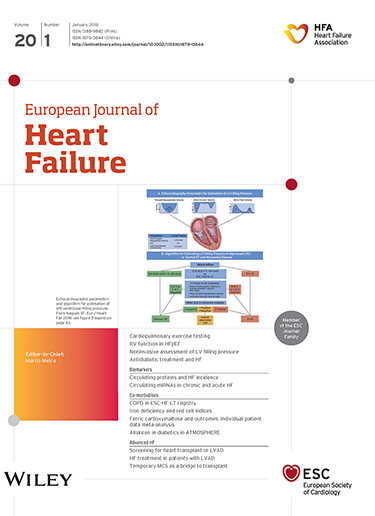European Journal of Heart Failure consensus statement. Heart failure pharmacotherapy for patients with heart failure with reduced ejection fraction and concomitant atrial fibrillation: Review of evidence and call to action.
IF 10.8
1区 医学
Q1 CARDIAC & CARDIOVASCULAR SYSTEMS
引用次数: 0
Abstract
Heart failure (HF) and atrial fibrillation (AF) are major global health challenges with rising prevalence and significant morbidity, mortality, and healthcare burden. Despite advances in HF management, AF remains a critical comorbidity that worsens outcomes and requires ad hoc treatment strategies, increasing the risk of non-adherence and side effects. While rhythm control strategies in AF have gained attention for their prognostic benefits in HF, the pharmacological treatment of HF in patients with AF, including the benefit of rhythm versus rate control, remains underexplored. The relationship between HF and AF lacks sufficient evidence and targeted research to assess the optimal treatment strategies. This narrative review critically examines current HF pharmacotherapy in the context of AF, focusing on the four cornerstone treatments and modifiers of prognosis for HF with reduced ejection fraction: beta-blockers, angiotensin-converting enzyme inhibitors/angiotensin receptor blockers/sacubitril-valsartan, aldosterone antagonists, and sodium-glucose co-transporter 2 inhibitors. Although these therapies are well-established in HF patients, their efficacy in patients with concomitant AF requires further prospective investigation. The unique challenges posed by AF, including arrhythmia-induced remodelling and cardiomyopathy, necessitate a more individually tailored treatment. We also highlight critical knowledge gaps and the need for dedicated clinical trials specifically assessing HF therapies in AF subgroups, such as paroxysmal, long-standing persistent and permanent AF, and the benefit of heart rate and rhythm control strategies. The future of precision medicine in HF-AF management lies in bridging these evidence gaps through targeted research and interdisciplinary collaboration.欧洲心力衰竭杂志共识声明。心力衰竭药物治疗心力衰竭伴射血分数降低并伴有心房颤动:证据回顾和行动呼吁。
心力衰竭(HF)和心房颤动(AF)是全球主要的健康挑战,其患病率和显著的发病率、死亡率和医疗负担都在上升。尽管在心衰管理方面取得了进展,但房颤仍然是一个严重的合并症,它会恶化预后,需要特殊的治疗策略,增加了不依不从和副作用的风险。虽然房颤的心律控制策略因其对心衰的预后益处而受到关注,但房颤患者心衰的药物治疗,包括心律与心率控制的益处,仍未得到充分探讨。心衰和房颤之间的关系缺乏足够的证据和有针对性的研究来评估最佳治疗策略。这篇叙述性综述严格审查了目前房颤背景下HF的药物治疗,重点关注射血分数降低的HF的四种基础治疗和预后调节剂:β受体阻滞剂、血管紧张素转换酶抑制剂/血管紧张素受体阻滞剂/苏比特-缬沙坦、醛固酮拮抗剂和钠-葡萄糖共转运蛋白2抑制剂。尽管这些治疗方法在心衰患者中已得到证实,但其对合并房颤患者的疗效还需要进一步的前瞻性研究。房颤带来的独特挑战,包括心律失常引起的重构和心肌病,需要更个性化的治疗。我们还强调了关键的知识缺口和专门的临床试验的必要性,专门评估心房颤动亚组(如阵发性、长期持续性和永久性心房颤动)的心衰治疗,以及心率和节律控制策略的益处。精准医学在HF-AF管理中的未来在于通过有针对性的研究和跨学科合作弥合这些证据差距。
本文章由计算机程序翻译,如有差异,请以英文原文为准。
求助全文
约1分钟内获得全文
求助全文
来源期刊

European Journal of Heart Failure
医学-心血管系统
CiteScore
27.30
自引率
11.50%
发文量
365
审稿时长
1 months
期刊介绍:
European Journal of Heart Failure is an international journal dedicated to advancing knowledge in the field of heart failure management. The journal publishes reviews and editorials aimed at improving understanding, prevention, investigation, and treatment of heart failure. It covers various disciplines such as molecular and cellular biology, pathology, physiology, electrophysiology, pharmacology, clinical sciences, social sciences, and population sciences. The journal welcomes submissions of manuscripts on basic, clinical, and population sciences, as well as original contributions on nursing, care of the elderly, primary care, health economics, and other related specialist fields. It is published monthly and has a readership that includes cardiologists, emergency room physicians, intensivists, internists, general physicians, cardiac nurses, diabetologists, epidemiologists, basic scientists focusing on cardiovascular research, and those working in rehabilitation. The journal is abstracted and indexed in various databases such as Academic Search, Embase, MEDLINE/PubMed, and Science Citation Index.
 求助内容:
求助内容: 应助结果提醒方式:
应助结果提醒方式:


